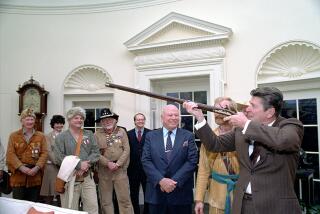Populism Is Back, Redefined, and Redefining the Mainstream
- Share via
For two decades now, Populists have been calling for a return of “power to the people.” But with Populism, everything hinges on whom “the people” include. During the 1960s, Populists tended to divide into left-wing and right-wing factions to the point that the definition of Populism became blurred.
In the 1980s, however, economic threats have brought a renewal of the Populist coalition. The Silent Majority worries increasingly about the ethic of unrestrained greed and the big-business policies of the Reagan Administration. As one small-town Republican mayor recently told me, “Everybody’s going their own way these days. If something’s not done, ordinary people are just going to lose out.” His point of view reflects the re-emergence of a Middle American Populism that could prove the swing vote in the 1988 election and work major changes long after.
The ‘60s new-left protesters were adept at Populist imagery. Their slogan, “power to the people,” became a familiar cry from clenched-fisted demonstrators rallying against the war in Vietnam, “police brutality” and a variety of other ills. But for the student left, “the people” was a select group, consisting of youth, the poor, minorities and the alienated. As militancy faded, liberals picked up the habit of appealing to out-groups who felt themselves most victimized by “the system.” But they paid dearly for the public perception that hard-working, church-going, patriotic middle-class citizens were not included.
Right-wing Populism also had its upswing in the 1960s. George Wallace railed against “overeducated, ivory-tower folks with pointed heads looking down their noses at us” and promised, if elected President, to throw Washington bureaucrats’ briefcases into the Potomac. Ronald Reagan, calling himself the “champion not of the country club set but of the small businessman and the blue-collar workers,” proposed a return of power to local areas and to the private sector. Through these appeals, Reagan gave more genial Populist expression to the same lower-middle-class resentments that Wallace had spoken to, and he triumphed as a result.
But President Reagan’s “Populist” coalition was inherently unstable. It consisted of corporate executives, small-business people, ethnic Catholics, Southern whites, religious evangelicals and others who liked his denunciations of liberal elitists but had sharply divergent interests themselves. In practice, policies favoring big business and upper-class suburbanites on economic issues and right-wing religious groups on social issues made Reagan’s Administration increasingly vulnerable to Populist economic challenges from the middle. As the result of merger mania, speculation and the “me first” morality encouraged by the Administration, most Americans have growing uncertainties about the future.
Almost half of the jobs created between 1979 and 1985 pay less than designated “poverty levels.” Nationwide, 70% of new jobs have been in service industries--with wages on the average about 83% of those in manufacturing--while millions of manufacturing jobs disappeared. Middle-class incomes declined in real terms for the first half of the decade. The country moved toward a “two-tier society” of the very rich and growing numbers of poor. For the poorest 20% of Americans, family incomes have dropped one-third over the last 15 years. The share of the nation’s wealth held by the richest 1% has increased in the same period from 27% to almost 36%--very close to the peak reached in 1929, just before the Great Depression.
Signs of a new mainstream Populism have appeared in the last two years in many guises. Singers like Bruce Springsteen and John Cougar Mellencamp speak to the failed dreams of those who spend their lives “playing by the rules,” only to discover that the game has changed. Farmers’ protests, urban neighborhood groups, suburbanites rallying against toxic waste and parents demanding better schools all suggest a “revolt of the middle.”
The key to middle-class Populism is the language of self-interest, which differs from right-wing selfishness or left-wing altruism. Populist self-interest stresses the practical need for teamwork and raises issues like education, health care, family values and a challenge to unproductive speculation and white-collar crime. Even Republicans have begun to express worries about the selfishness and privatism that have flourished in recent years.
The Populists represent an enormous swing vote of the American electorate, cutting across races, regions, religious groups and urban-rural divisions. A Democrat who articulates Populist themes could reverse the erosion of Democratic presidential strength in Southern and Western states, and might well achieve victory.
More to Read
Get the L.A. Times Politics newsletter
Deeply reported insights into legislation, politics and policy from Sacramento, Washington and beyond. In your inbox twice per week.
You may occasionally receive promotional content from the Los Angeles Times.









